Who says you need a telescope to see craters on the Moon? Here's how to find a half-dozen with just the naked eye.
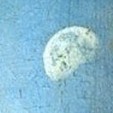
I've always wondered what the ancients saw in the Moon. Not metaphorically, but did anyone record the dark and bright blotches visible with the naked eye using ink and papyrus? Stone on stone?
Symbolic representations of the Moon abound, and there may even be a 4,800-year-old Neolithic engraving of lunar features cut into a stone found in an ancient burial mound near Knowth, Ireland. Dr. Philip Stooke sees the outlines of lunar maria in the concentric arcs hammered into curbstones at the site.
Leonardo da Vinci is often cited as the first person to realistically depict lunar features visible with the naked eye, but the earliest known non-symbolic image belongs to Flemish artist Jan van Eyck, who painted a waning gibbous Moon in his Crucifixion and Last Judgement diptych. Not only is his a good lunar likeness, the Moon's tilt toward the southwestern horizon jives with the time (3 p.m.) when Christ is said to have died on the cross.
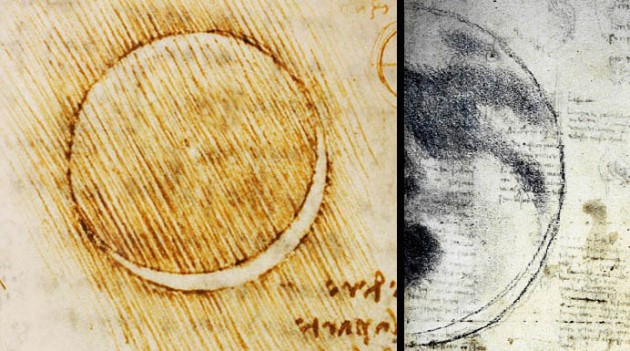
Codex Leicester, fol. 2r / Codex Atlanticus. fol. 674v
Leonardo's charcoal sketch, made around 1513-14, looks familiar to any Moon watcher, but portrays only dark maria against white lunar highlands. Another notebook entry depicts a sunlit crescent edging a beautiful depiction of earthshine.
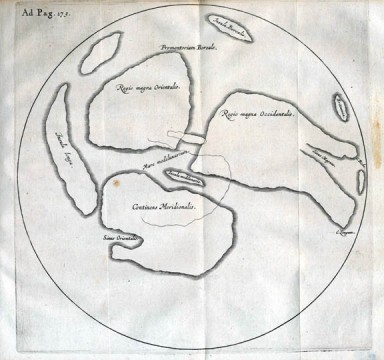
De Mondo Nostro Sublunari, facing p. 137
William Gilbert, best known for his book on magnets and magnetism written in 1600, also tried his hand at lunar sketching and took the next step by naming the features he recorded. While there's a certain precision to Gilbert's map, it lacks other obvious lunar highlights like Copernicus, Kepler, and Aristarchus, three of the craters we'll examine in this article.
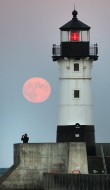
Bob King
I'm sure I've stared at that threesome ever since I first looked up at the Moon as a boy. Like many before me, I was entranced by the dark maria and the creature-patterns they've evoked through the generations: Man in the Moon, Dragon, Rabbit, Woman, Tree, and many more. But it wasn't until more recently that I realized what I was looking at — craters!
I love our ability to see patterns in the abstract, but there's more on that shiny disk than meets the imagination. Even if your vision is unexceptional like mine, you can spot up to half a dozen craters with nothing more than the equipment you were born with.
Most of the naked-eye craters have one thing in common — they're surrounded by rays, radial streaks of bright ejecta tossed out during their formation by impact. Rays not only "enlarge" a crater's appearance, but the material excavated is fresh and un-darkened by the effects of space weathering, so contrasts well against the dark, hardened lavas of the lunar seas. Strictly speaking, we can't discern the outlines of the smaller craters, but they contribute to the overall visibility of the rayed systems.
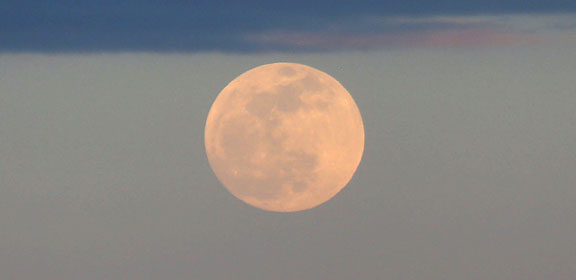
Bob King
While there are hundreds of rayed craters, only a few are large enough and situated in dark maria for good visual contrast. The best time to view the four most prominent — Aristarchus, Copernicus, Kepler, and Tycho — is from two days before full Moon to two days after (though the first three remain in good view until last quarter phase). The high Sun at this time highlights lunar rays.
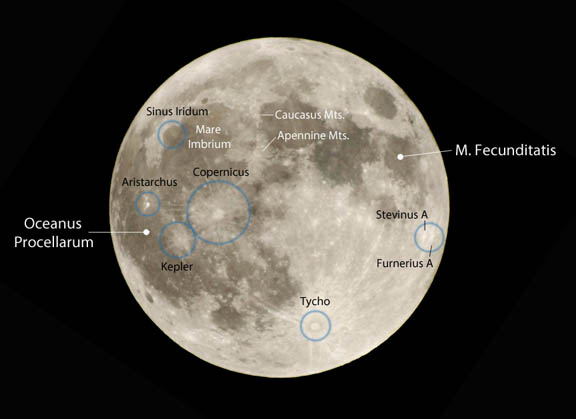
Bob King
Copernicus, a 58-mile-wide crater, sits at the helm of a ray system stretching over 435 miles (700 km), or some 6 arcminutes. The easiest to see of the bunch, it looks like a fuzzy white blotch in the eastern half of Oceanus Procellarum to the left (west) of the Moon's center. When you consider that the average visual acuity of the human eye is one arcminute, Copernicus will prove an easy catch once you know where to look.
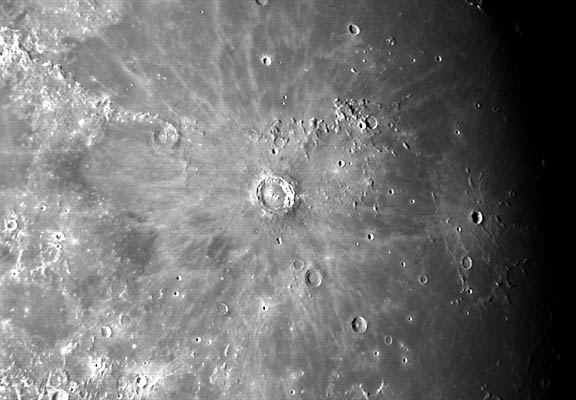
William Wiethoff
Staring directly at the the fuzzy splat, I can occasionally see the "whiter core" of the Copernicus system, comprised of the actual crater and its immediate bright rays. At 0.8′ (arcminutes) across, the crater alone hovers at the naked-eye limit. Kepler Crater is smaller yet at just 20 miles (32 km) in diameter, but a nimbus of rays expands its presence to around 185 miles (300 km), equal to 2.6′. While Kepler itself remains well-hidden, its encompassing rays are quite obvious against the deeps of Oceanus Procellarum.
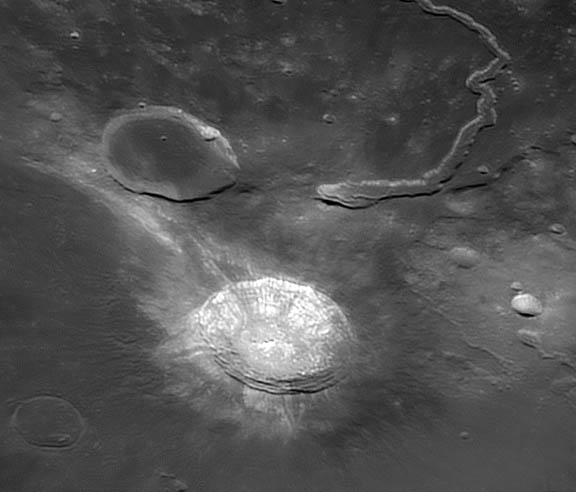
Damian Peach
Aristarchus is not only one of the brightest craters on the Moon, but wears a brilliant rayed ruff roughly 155 miles across (250 km). And while it lies relatively close to the lunar limb, especially at unfavorable librations, I never fail to see it. Together with Copernicus and Kepler, it forms a triangle trio spread across the vast lunar ocean.
Tycho's a horse of a different color. Although this 53-mile-wide (85 km) crater possesses the grandest crown of lunar rays, most of the material, including the crater itself, are set against the blinding glare of the lunar highlands. Despite a lack of contrast, Tycho size and freshness combine to make it visible to the naked eye as a tiny, bright concentration of light just south of Mare Nubium. Given that Tycho measures only 0.7′ in diameter, I have to assume we're seeing both the crater and its innermost cap of bright rays.
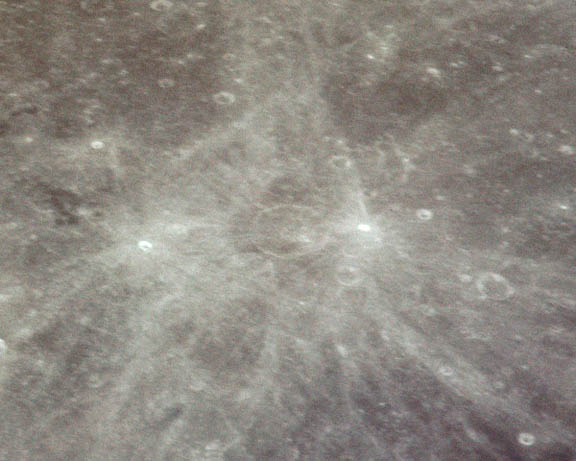
Credit: NASA
Stevinus A (5 miles/8 km diameter) and Furnerius A (7.5 miles/12 km) form a close pair of small craters adorned with brilliant rays; look for them on the opposite side of the Moon from the Copernicus trio. I saw this duo even before I thought to look for it. Their combined light blends into a single, amorphous spot south of Mare Fecunditatis, best seen in twilight rather than in a dark sky. As a matter of fact, you may find that other crater systems stand out better in twilight when the blue sky tames the lunar glare. Try looking at both times and see which works better for you.
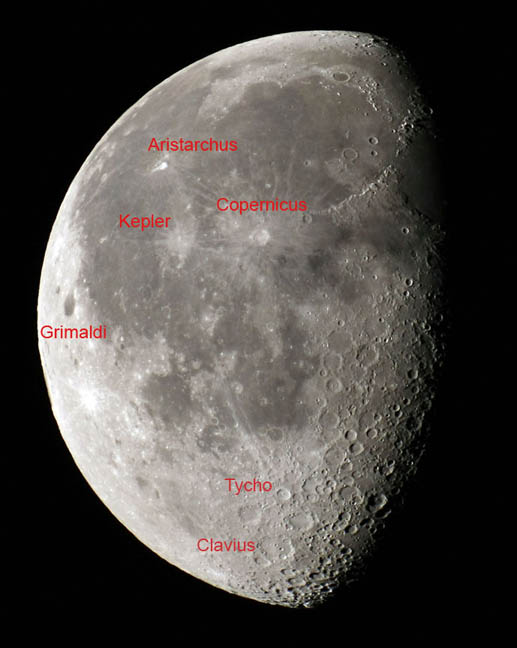
Bob King
I've tried to detect other potential naked-eye candidates, including Plato (dark against bright highlands) and the bite of Langrenus in the eastern shore of Mare Fecunditatis, without luck. It's said that the dark pool of Grimaldi located just inside the far western limb, as well as the large crater Clavius south of Tycho, can be glimpsed with the naked eye when phase and libration are favorable. To determine the best dates for viewing craters near the limb, try the Moon Libration Applet or select a date at CalSky's Moon View site for detailed libration information. This information is also available in the "Inside This Issue" section of the most recent issue of Sky & Telescope.
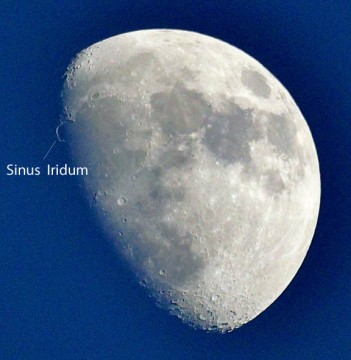
Stephen Little
I've done better with Sinus Iridum, the 147-mile-wide (236 km) lava-flooded crater along the northwestern border of Mare Imbrium better known as the Bay of Rainbows. When low-angled sunlight grazes the crater's wall around the time of the 10-day-old Moon, averted vision coaxes it into view as a bright extension poking over the terminator into the lunar night.
What a marvel the human eye. Always up to the challenge. Trust what it can reveal, and you'll see far. Happy moongazing!
 2
2


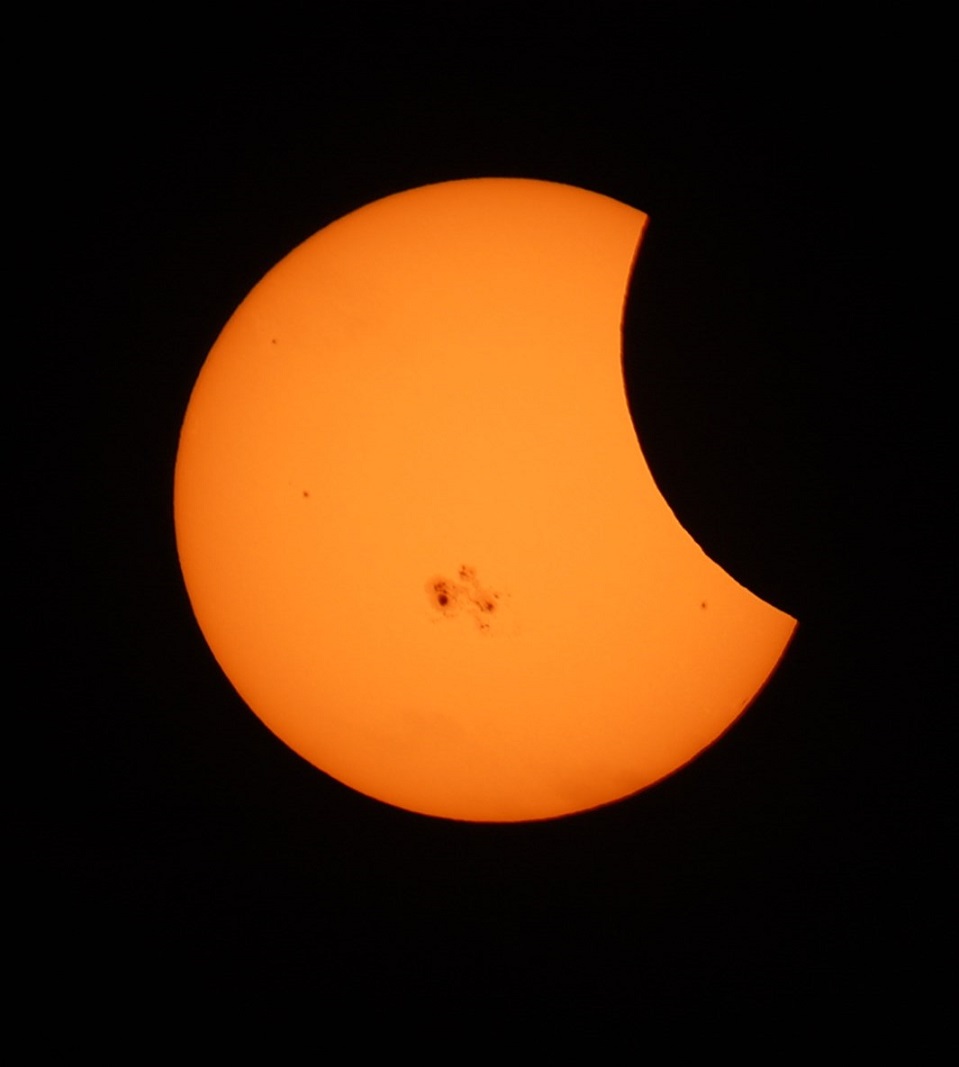






Comments
KONSTANTIN_V
January 26, 2018 at 6:36 am
I have been studying astronomy for 30 years (now I'm 37 years old). Nature has given me very good eyesight, I see more than all my colleagues are astronomers. The moon with the naked eye I see like this [img]https://i.imgur.com/zDDOzFU.jpg[/img] https://imgur.com/zDDOzFU
You must be logged in to post a comment.
Bob KingPost Author
January 26, 2018 at 9:45 am
Dear Konstantin,
Thank you very much for sharing your sketch. You prove the power of the naked eye.
You must be logged in to post a comment.
You must be logged in to post a comment.